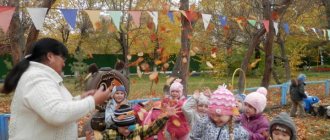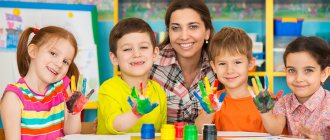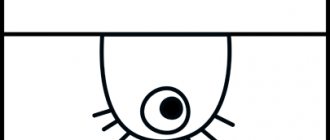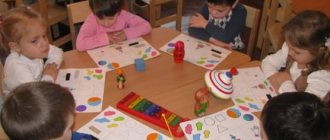Joint partnership between an adult and preschool children
Lyubov Dushebaeva
Joint partnership between an adult and preschool children
In connection with the introduction of the Federal State for preschool education, approaches to organizing activities in kindergarten . The leading type of activity is the joint activity of an adult and a child , in which the teacher becomes a partner .
The main features of joint activities of adults and children are highlighted - the presence of a partner position of an adult and a partner form of organization of activity , by which we mean such factors as cooperation between adults and children and the possibility of free movement and communication of children.
An essential feature of partner activity between an adult and children is its openness towards the free independent activity of preschoolers themselves . At the same time, adult partner activities are open to design in accordance with the interests of children.
Speaking about the partner position of the educator , we mean that he is an equal participant in the activity and, as such, is connected with others by mutual respect. between teachers and children . Respect is a necessary element in the community that the kindergarten group is. Educators set the example of mutual understanding, respect and care for each other that they expect from children.
partner position contributes to the child's development of activity, independence, the ability to make decisions, try to do something without fear that it will turn out wrong, evokes a desire to achieve, and promotes emotional comfort.
Positions of the teacher at different moments of joint activity .
The teacher invites children to engage in activities at ease :
• Let's do it today.
• Anyone who wants to, make yourself more comfortable.
• Anyone who wants to join.
Having outlined a task for joint completion , the adult and children find possible ways to implement it. In the process of activity, the teacher “sets”
developmental content
(new knowledge, methods
of activity, etc. ) .
Offers his idea or his result for children's criticism. Shows interest in the results of others, is included in the mutual assessment of the participants’ actions, and also increases the child’s interest in the work of a peer, encouraging meaningful communication. of activity is also structured in a special way . Each child works at his own pace and decides for himself whether he has finished the work or not. adult assessment of children’s actions is necessary , but it can only be given indirectly, as a comparison of the result with the child’s goal: what he wanted to do - what happened.
Thus, the essential characteristics of organizing classes in the form of partnership activities between an adult and children are :
involvement of adults in activities on an equal basis with children ;
voluntary participation of children in activities ;
free communication and movement of children during joint activities ;
open time end of joint activity (everyone works at their own pace)
The partner form of the lesson also requires a certain organization of the activity : it is necessary to get as close as possible to the “round table”
inviting equal participation in work, discussion, research.
This can be a free arrangement of all participants (including
an adult ) at a real round table, on the carpet, or around several common tables with materials for work and experimentation.
Children freely choose work places and move around to take this or that material. The adult partner is always together (next to)
with
the children , in a circle. Children realize their interests in various types of activities mainly independently, and an adult is not only obliged to create conditions for stimulating the child in various types of activities , he needs to focus on the interests, needs and abilities of children. An adult is involved in activities on an equal basis with children , not only is present during the work, but also strives to obtain the final product, supporting this desire among the other participants.
The teacher adheres to the following rules. There is no need to rush to the child’s aid at the first difficulty; it is more useful to encourage him to make an independent decision; if you cannot do without help, at first this help should be minimal: it is better to give advice, ask leading questions, and activate the child’s past experience. It is always necessary to provide children with the opportunity to independently solve assigned problems, to direct them to find several options for solving one problem, to support children’s initiative and creativity, to show children the growth of their achievements, to instill in them a feeling of joy and pride from successful independent, proactive actions. When a teacher becomes a child’s partner , and therefore an equal participant in the overall work, the following changes as a result:
style of behavior of an adult (from administrative-regulatory to relaxed-trusting)
;
workspace where collaboration (from a separate place behind the “teacher’s”
table to a place at the common table next to
the children );
the teacher’s attitude to the performance of general work: from general guidance to participation in the implementation of a certain part of the work.
Thus, when organizing classes in the form of joint partnership activities, the situation of children changes.
Children can decide for themselves whether or not to participate in the common work. But this is not the introduction of permissiveness and anarchy. The child has the opportunity to choose - to participate in this work or organize something else, do something else. If the teacher correctly selects content for entertaining activities with preschoolers that corresponds to their interests, and is emotionally attuned to the proposed activity, problems simply do not arise.
The order and organization of joint activities : free placement of children at a common table, their communication with other children as they work and moving as needed. As work progresses, children can turn to the teacher, approach him, discuss with him issues of interest related to the performance of work, and receive the necessary help and advice.
Children can work at different paces. Each child can determine the amount of work for himself: what he will do, but he will do it well and finish the job he has started. Children who finish work early can do what interests them. If the child did not cope with the work, he can continue it in the following days.
Modern approaches to organizing the educational process require a revision of traditional technologies, which are not effective in achieving the goal of social success of preschoolers at the next stage of education. At the moment, it is necessary to focus on the following principles of working with children in the form of joint partnership activities :
moving away from strictly regulated school-type education;
the use of diverse forms of training organization, including different types of activities ;
ensuring the relationship between joint activities and the daily lives of children and their independent activities .
creation of a developmental subject environment that functionally models the content of children's activities
widespread use of methods that activate children's thinking, imagination and search activities . Introduction to teaching of problematic elements, open-ended tasks with different solutions;
widespread use of gaming techniques and toys; creating situations that are emotionally significant for children;
between an adult and children and children among themselves as the leading one in the educational process adults ;
Thus, modern approaches to organizing the educational process determine the partnership position and partnership activities of the teacher with children as the basis for joint activities in a preschool institution , as a necessary requirement for the implementation of the Federal State Educational Standard for preschool education
Tasks of younger preschool age
Thus, in primary preschool age the tasks are as follows:
- stimulate interest in the proposed activities;
- involve children in the learning process;
- for the formation of various concepts;
- Involve children in reproducing pictures using a variety of options;
- Encourage children to jointly explore and experiment.
Improvement of mental processes:
- Formation of emotional interest;
- Familiarization with objects and actions with them;
- development of thinking and imagination;
- Language development.
Formation of skills and abilities of project research:
- awareness of the goal;
- Possession of various methods of solving assigned problems;
- Ability to predict results based on past experience;
- Look for different means to achieve your goal.
Lines of personality development in early preschool age according to directions.
1) Physical development:
- Stimulating the natural process of development of motor skills and qualities;
- Formation of conscious ideas about the need to take care of one’s own health (for example, the role-playing project “The ABC of Health”);
- Social development: formation of communication methods (for example, opening “My Family”, individual family projects “Family Tree”).
2) Cognitive development:
- Enrichment and expansion of ideas about the world around us;
- expansion and qualitative change in the possibilities of orientation in the surrounding world;
- conscious use of the senses when solving practical problems (for example, mathematical collages, intergroup project “The World of Animals and Birds”, creative projects “My Friends”, “The World of Nature”).
3) Aesthetic development:
- Development of an emotional-evaluative attitude towards works of art and artistic images;
- Mastery of artistic activities (for example, complex projects “World of Theater”, role-playing projects “Favorite Toys”, etc.).
The second stage is developmental, it is typical for children 5-6 years old, who already have experience in various joint activities, can coordinate actions, and help each other. The child makes requests to adults less often and organizes joint activities with peers more actively.
Children develop self-control and self-esteem; They are able to fairly objectively evaluate their own actions and the actions of their peers. At this age, children accept the problem, clarify the goal and are able to choose the means necessary to achieve the result of the activity. They not only show a willingness to participate in projects proposed by adults, but also find problems on their own.
The third stage is creative, it is typical for children aged 6-7 years. At this stage, it is very important that adults develop and support children’s creative activity, create conditions so that children can independently determine the purpose and content of the upcoming activity, choose a way to work on a project and be able to organize it.
Tasks of senior preschool age
Therefore, tasks for senior preschool age:
- Search activities for the development of intellectual initiative;
- develop special ways of orientation - experimentation and modeling;
- to form generalized techniques of mental work and means of building one’s own cognitive activity;
- develop the ability to predict future changes.
Creating conditions for educational activities:
- Arbitrariness in behavior and production activities;
- the need to form your own picture of the world;
- communication comprehension skills.
Formation of skills and abilities of project research:
- identify the problem;
- independently search for the desired solution;
- choose the most suitable method and use it productively;
- independently analyze the results.
Lines of personality development in senior preschool age in the following areas:
1) social development:
- Development of self-knowledge and positive self-esteem;
- mastery of methods of non-situational and personal communication;
- high level of communicative competence;
- Awareness of the functions of language (for example, the “My Family” project, group projects “Know Yourself”).
2) Physical development:
- Development of a conscious approach to one’s own health;
- Formation of the need for a healthy lifestyle;
- Improving the process of developing motor skills and qualities (for example, role-playing projects “The ABC of Health”, “Secrets of Ilya Muromets”).
3) Cognitive development:
- Systematization of knowledge, promoting the development of cognitive and creative abilities;
- Development of skills in practical and intellectual experimentation and symbolic modeling, language planning, logical operations (for example, the Book Lovers Club “Magic Country”; group projects “Underwater World”, “Fun Astronomy”; intergroup project “Seasons”).
4) Aesthetic development:
- In-depth acquaintance with art, a variety of artistic images;
- Mastering various types of artistic activities;
- Developing the ability to make aesthetic judgments.
Thus, project activity forms the child’s subjective position, reveals his individuality, realizes his interests and needs, which in turn contributes to the development of the child’s personality. This corresponds to the social system at the present stage.
The peculiarity of interaction when applying the project method in preschool practice is that adults must “guide” the child, help in identifying a problem or even provoke its occurrence, arouse interest in it and “draw” children into a joint project, but at the same time not overdo it in helping and caring.
Planning of project activities begins with the questions: “What is the project for?”, “What is it for?”, “What will be the product of the project activity?”, “In what form will the product be presented?”
Work on the project, including the development of a meaningful action plan, which is formed and refined during the period, goes through several stages. At each stage, the teacher’s interaction with children is personality-oriented.
Having summarized the experience of developing the project method, we can distinguish the following stages of work on the project:
- Goal setting: The teacher helps the child choose the most relevant and feasible task for a certain period of time.
- Project development - action plan to achieve the goal:
- Who to turn to for help (adult, teacher);
- what sources of information need to be found;
- what things to use (materials, equipment);
- what elements you need to master to achieve your goal.
3. Project implementation - practical part.
4. Summary - defining tasks for new projects.






